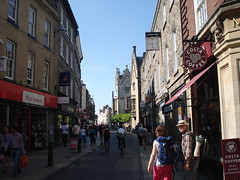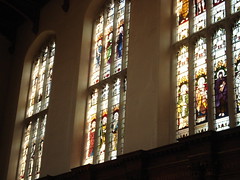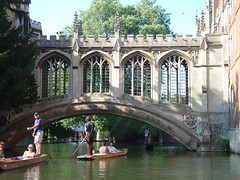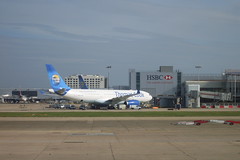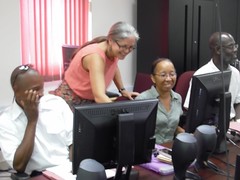 Latitude: 53° 57′ 43″N, Longitude: 1° 4′ 55″W
Latitude: 53° 57′ 43″N, Longitude: 1° 4′ 55″WWe woke up early to get a start on what was to be a long day. All days are long on this trip, with the light of day lasting from 5 in the morning (at least) to well over 9 pm, there’s no excuse for not seeing everything. This morning, we climbed to the top of York Minster...273 steps (Tillie counted) and much huffing and puffing later we had an awesome view of the beautiful city of York. The building tops reflect the red brick used in all local buildings.
 We got up close with gargoyles and saw the fabulous flying buttresses designed to keep propped up the long, narrow and yet extremely tall cathedral that is the Minster. If you go to York, don’t miss climbing to the top of the Minster.
We got up close with gargoyles and saw the fabulous flying buttresses designed to keep propped up the long, narrow and yet extremely tall cathedral that is the Minster. If you go to York, don’t miss climbing to the top of the Minster. Once back down on ground level, we took our time in the cathedral. We didn’t have time yesterday to explore the Minster. The stained glass windows are extraordinary. The Great East Window, which is over 70 feet tall and contains the largest area of medieval stained glass in a single window, was undergoing renovation. This turned out to be our good fortune as we got to see some of the panes up close, and in place of the Great East Window was what was billed as the largest digital poster anywhere. I don’t know about all that, but it made for a great display that provided a history of what each of the panels represented. This information would not otherwise have been displayed. The East Window gives the biblical history from the Old Testament to the New Testament. They had on display stained glass panels that were yet to be renovated and another that was in perfect shape. It was a very informative display.
Once back down on ground level, we took our time in the cathedral. We didn’t have time yesterday to explore the Minster. The stained glass windows are extraordinary. The Great East Window, which is over 70 feet tall and contains the largest area of medieval stained glass in a single window, was undergoing renovation. This turned out to be our good fortune as we got to see some of the panes up close, and in place of the Great East Window was what was billed as the largest digital poster anywhere. I don’t know about all that, but it made for a great display that provided a history of what each of the panels represented. This information would not otherwise have been displayed. The East Window gives the biblical history from the Old Testament to the New Testament. They had on display stained glass panels that were yet to be renovated and another that was in perfect shape. It was a very informative display.Next, we walked south and east to The Shambles. This is a lovely little street but not that remarkable compared to other lovely little streets that one can observe (as we have) all over England. Anyway, amble through The Shambles as you make your way to other points of interest in York.
Latitude: 53°57'20.91"N, Longitude: 1° 4'48.00"W
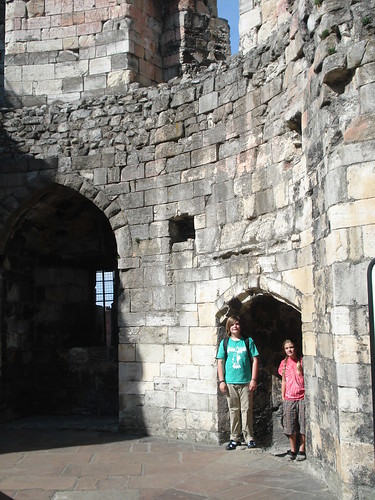 We went to Cliffords Tower. This is a strange and small remnant of a large castle at the top of a hill. It is also the site of a siege upon York’s Jews in 1190. A lot seemed to happen in England during the Norman Conquest around 1066 and the flushing out of Jews was one of them. Why must history continue to repeat? Anyway, Cliffords Tower is worth a visit because it is a true shambles. It is fairly well crumbling down, though one must pay to enter the structure. The tower that remains was once part of an enormous castle built by Henry III. One thing I’ve learned is that castles were for armament and protection, palaces were where the nobles lived and the cathedrals were places of worship and teaching of Christian scriptures. Cliffords Tower was a castle, an armament. The Minster is a cathedral. It is in beautiful shape and continues to be a place where regular services occur. It struck me as odd that the castle is allowed to crumble down and yet the Minster is undergoing near constant renovations as is needed for a place built on this spot nearly 2,000 years ago and in this stone building form nearly 1,000 years ago.
We went to Cliffords Tower. This is a strange and small remnant of a large castle at the top of a hill. It is also the site of a siege upon York’s Jews in 1190. A lot seemed to happen in England during the Norman Conquest around 1066 and the flushing out of Jews was one of them. Why must history continue to repeat? Anyway, Cliffords Tower is worth a visit because it is a true shambles. It is fairly well crumbling down, though one must pay to enter the structure. The tower that remains was once part of an enormous castle built by Henry III. One thing I’ve learned is that castles were for armament and protection, palaces were where the nobles lived and the cathedrals were places of worship and teaching of Christian scriptures. Cliffords Tower was a castle, an armament. The Minster is a cathedral. It is in beautiful shape and continues to be a place where regular services occur. It struck me as odd that the castle is allowed to crumble down and yet the Minster is undergoing near constant renovations as is needed for a place built on this spot nearly 2,000 years ago and in this stone building form nearly 1,000 years ago.Latitude: 53°57'26.49"N, Longitude: 1° 4'48.67"W
A feature we included as a late minute addition was the Jorvik Viking Center. This place was great. It is an excavation on this site in York showing mostly Viking remains but also some Roman artifacts. This was a very interactive and informative exhibit. The kids loved it and especially liked the ride through a mock Viking village (complete with real smells of the olden days…eew) and docents who really know their Viking stuff. Either they were archaeologists or enthusiasts but we learned a ton about the fair-haired Norse-folk.
These photos and more from the trip are located on my Flickr page.



